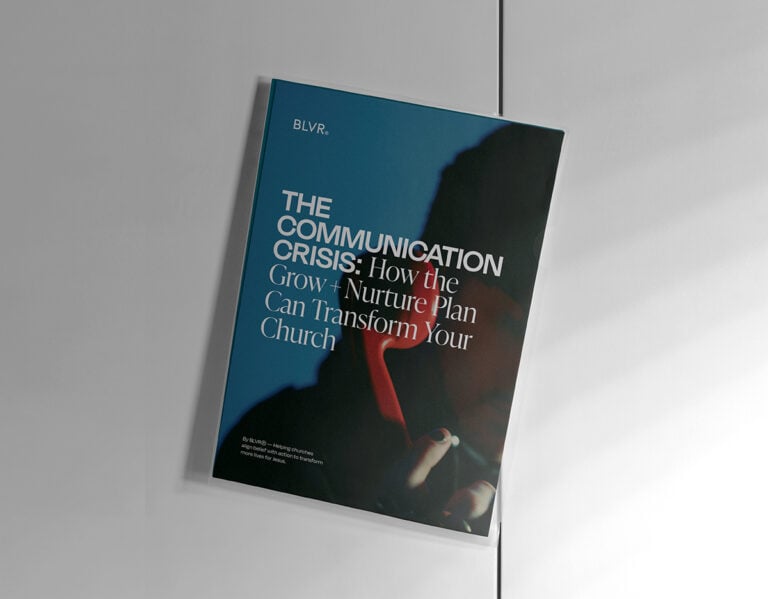
Church Branding / BY Derek Scott
How to Find Your Church’s Voice (And Make Sure Everyone Uses It)
Published On 04.07.2025
Article
Clear up confusion, amplify your impact, and finally get everyone speaking the same language
I recently got the chance to partner with BLVR to serve a church in northern California that was facing an identity crisis. Like, a massive one.
Their leaders, staff, and congregation members were all describing their church differently. They were using conflicting language and everyone was emphasizing different values. All this landed them with a fractured perception of who they really were.
No one was speaking the same language, and it was crippling the church’s impact.
After helping them solidify their verbal identity, we saw what we always see. Church leadership and the congregation began speaking with one voice. The transformation was immediate and powerful because everyone started rowing in the same direction, which amplified their message instead of diluting it.
And in the church world, diluting the message of the Gospel isn’t something any church… or anyone here at BLVR… wants.
If Your Church Doesn’t Have a Consistent Voice, You’re in Good (and Crowded) Company
“We need a consistent voice.” It’s something we hear from churches all the time. And honestly, if your messaging feels scattered or unclear, you’re in very good company.
Here’s what’s really going on: Many churches struggle with a gap between what they say they want—clear, effective communication—and what actually happens day-to-day. We like to call this the
“Say-Do Gap.” Without clear guidelines, your message naturally becomes fragmented. And that’s frustrating for everyone involved.
Fortunately, the solution isn’t complicated. It just requires intentional effort.
By clearly defining your church’s “verbal identity”—your core messaging, voice attributes, and editorial standards—you can close that gap and dramatically sharpen your impact.
When you speak with one unified voice, your leadership and congregation stops feeling confused and starts becoming enthusiastic advocates for your mission.
And here’s something else worth remembering: Generic or inconsistent language won’t just fail to resonate. It actively undermines what you’re trying to accomplish
“The tongue has the power of life and death, and those who love it will eat its fruit.”
— Proverbs 18:21
The Six Essential Elements of Your Church’s Verbal Identity
Let’s be clear: A verbal identity isn’t a “nice to have,” but a mandatory. Why? Because it’s the difference between a church that speaks with authority and one that babbles in confusion.
A verbal identity consists of six critical elements that work together to create a coherent, compelling voice:
- Naming & Nomenclature: This goes beyond the name of your church. It’s about consistency in what you call your ministries, events, and programs. Whether it’s “Kids Ministry” or “Children’s Church,” consistent naming matters more than most people realize.
When naming is inconsistent, confusion reigns. But when purposefully developed, your nomenclature creates an intuitive system that reinforces your identity with every word. - Tagline: A powerful tagline succinctly expresses your church’s purpose and promise. It’s more than just clever wording—it clearly answers why your church exists in a way that people can easily remember.
The most effective church taglines are both aspirational and actionable. They inspire while providing a clear sense of what engagement with your church offers. - Voice & Tone Editorial Guidelines: Often overlooked, yet critically important. These guidelines detail exactly how your church communicates—words you embrace, phrases you avoid, and how your tone shifts depending on context while maintaining your distinctive voice.
These guidelines ensure that whether someone is reading your website, listening to an announcement, or receiving an email, they experience the same distinctive voice that reflects your unique church culture. - Brand Story: This isn’t just your church’s history. It’s a carefully crafted narrative that connects your past, present, and future, and it articulates your vision and mission.
Your brand story should clearly convey not just what you do, but why it matters. - Elevator Pitch: Your staff and congregation shouldn’t stumble when someone asks, “What’s your church like?” A clear, concise elevator pitch helps everyone confidently describe what makes your church unique in about 30 seconds or less.
- Manifesto Script: Your manifesto boldly declares your beliefs, values, and commitments. It clearly defines what you stand for, and provides clarity and conviction around your mission. It should inspire and unite your congregation.
Creating and Implementing Verbal Brand Guidelines That Actually Work
Developing verbal brand guidelines isn’t an academic exercise. It’s a strategic imperative.
Here’s how to create guidelines that transform your church’s communication:
- Start with Deep Discovery: Before writing a single word, invest time in understanding your church’s unique culture, values, and personality. Conduct interviews with leaders, staff, members, and even those in your community who don’t attend. Ask probing questions like the following: What makes this church different? What words do people use to describe the experience here? What analogies or metaphors capture your ministry approach?
- Craft with Precision, Test with Patience: Developing your verbal identity elements requires both creativity and strategy. Craft multiple options for each element, then test them rigorously. Does this language resonate with both insiders and outsiders? Does it feel authentic to who you are while being aspirational about who you’re becoming?
- Document Clearly (And Make it Accessible): Clearly document your guidelines in an easy-to-follow format. Include examples of what works, what doesn’t, and specific instructions for different contexts, e.g., social media versus print collateral. Ensure your guidelines are accessible to everyone who communicates on behalf of your church.
- Train, Reinforce, and Gently Hold Accountable: Regularly train your staff and volunteers on these guidelines. Celebrate successes, reinforce good communication, and gently correct missteps to maintain consistency.
- Apply Across All Communication Touchpoints: Systematically apply your verbal identity across your website, sermons, emails, signage, and even informal conversations. Consistency breeds clarity.
Leveraging AI to Amplify (Not Replace) Your Authentic Voice
Here’s something many churches overlook: Artificial intelligence can be a huge help in maintaining verbal consistency, and making your communication clearer and more effective.
When properly trained with your verbal brand guidelines, AI tools can help you:
- Generate Content that Sounds Like You: Instead of starting from scratch, AI can quickly draft emails, announcements, and social media posts that consistently reflect your authentic voice.
- Scale Personalized Communication: You can use AI to personalize your messaging for different audiences—such as ministries or demographic groups—while preserving your church’s unique voice. This lets you tailor communication effectively without sacrificing consistency.
- Maintain Quality Control: AI can serve as a first-line editor that flags language or tone shifts that don’t align with your established guidelines. It can also help prevent off-brand messaging before it reaches your audience.
- Important: AI Amplifies, It Doesn’t Create Identity: Let’s be clear: AI cannot—and should not—define your verbal identity. Determining who you are as a church requires human discernment, spiritual sensitivity, and deep cultural understanding. AI is simply a helpful tool to consistently express the identity you’ve intentionally developed.
To effectively leverage AI:
- Clearly document your verbal identity guidelines.
- Integrate these guidelines into your chosen AI tool.
- Use AI for initial drafting, not for final content.
- Always include human review and editing.
- Regularly retrain your AI tools with successful communication examples
Start Speaking with One Voice—Your Church’s Mission Depends on It
The language your church uses profoundly impacts your mission. Every inconsistent message or unclear explanation can weaken your influence and diminish your effectiveness for the Kingdom.
Ask yourself honestly: Does your church currently have clearly documented verbal identity guidelines, or are you still improvising communication as you go?
Churches that implement intentional, strategic verbal identity guidelines quickly experience dramatic improvement. Communication becomes clearer. Visitors understand your church more quickly. Your congregation becomes confident ambassadors, and decision-making gets simpler for leaders.
Just like the church in northern California I mentioned earlier, you too can move from scattered messaging to clear communication. From confusion to clarity. From diluted impact to intentional influence.
It won’t happen by accident, but it’s absolutely worth the strategic, intentional effort.
Because the words your church chooses matter deeply.
Make them count.
YOUR NEW COMMS PLAN
Learn how your church can apply an approach that businesses have used to successfully acquire new customers and retain existing customers. Use the power of audience segmentation to deliver personalized messages that are relevant to each person within you external and internal church community.

About the Author

Derek Scott
Creative Director & Lead Copywriter
Derek Scott is the Creative Director and Lead Copywriter at Creator, an agency specializing in high-powered direct response copywriting. He founded Creator in early 2021 after nearly two decades of leading creative teams and writing copy at agencies serving the non-profit sector. Derek’s career includes a 15-year partnership with BLVR, where he has contributed to BLVR’s mission of transforming brands by aligning their convictions with actions.
© BLVR
SD / CA




